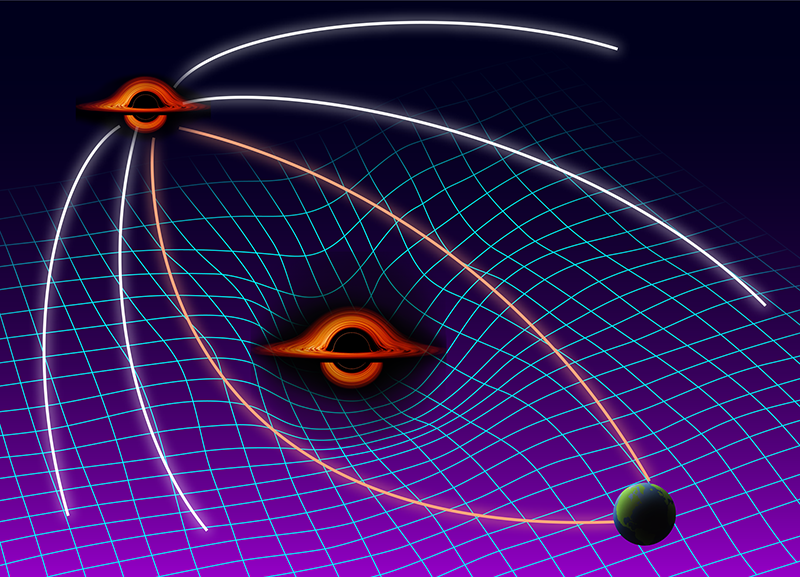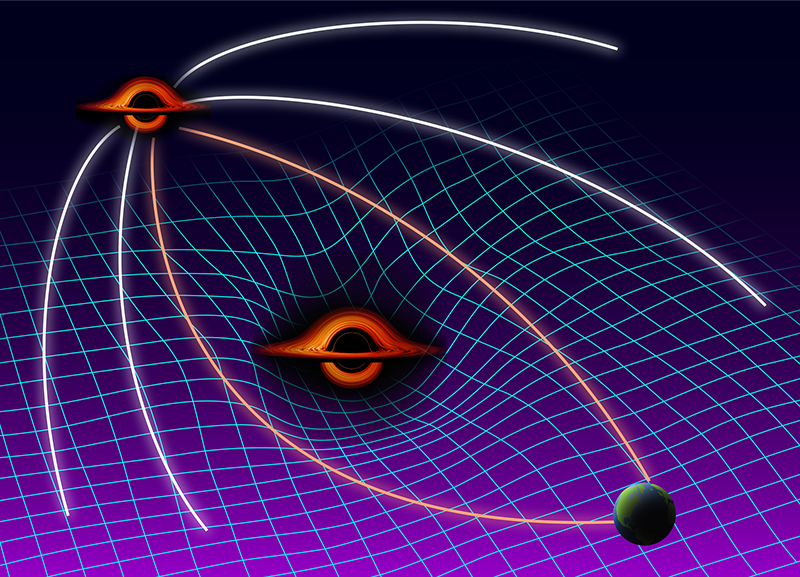Measuring a Black Hole Shadow
When galaxies collide, the central supermassive black holes that they contain begin to orbit each other. This supermassive black hole binary attracts gas, which flows through the system to form two disk-shaped structures, one around each of the supermassive black holes. The gas in these “minidisks” heats as it falls toward the holes and begins to radiate light. Astronomers have detected around 150 galaxies with candidate supermassive black hole binaries. And, as observations become more detailed, they expect the light from the minidisks in those systems to bear recognizable, time-dependent signatures from black hole distortions [1]. Now, Jordy Davelaar and Zoltán Haiman of Columbia University have theoretically tested how one such distortion—the “shadow” of the black hole—affects this light signature, finding that it causes a dip in the signal that should be observable in about 1% of candidate systems [2, 3]. The technique could allow astronomers to study black holes that are currently beyond the reach of conventional imaging methods (Fig. 1).
From gravitational-wave measurements of merging black holes to direct imaging of the plasma circling a black hole, the last decade has seen an explosion of observational evidence for black holes (see Viewpoint: The First Sounds of Merging Black Holes and News Feature: Black Hole Imaging Tests Einstein’s Limits) [4–6]. Yet despite these achievements, many questions remain about black holes, including a critical one: How do black holes grow to supermassive scales—millions to billions of times the mass of the Sun?
A black hole is a simple object, described by its mass, angular momentum, and electrical charge. Supermassive black holes are typically electrically neutral, so their mass and angular momentum parameters determine their gravitational fields. The gravitational field determines how the black holes bend light and thus how they appear to an observer on Earth. Light passing near the black hole is deflected by the gravitational field, producing a black hole shadow—a dark region that is often encircled by a bright light ring—whose size and shape come directly from the black hole’s mass and angular momentum.
Unfortunately for an Earth-bound observer, recovering an image of a black hole shadow is virtually impossible for all but the closest of supermassive black holes. That is because most supermassive black holes are too small to resolve in the night sky. This issue is particularly problematic for scientists wanting to understand how black holes grow, as the earliest black holes are the farthest from Earth and thus the smallest in the sky. Davelaar and Haiman predict that their method could capture the shadows of these otherwise unresolvable objects.
In their study, Davelaar and Haiman numerically simulated black hole binaries in a variety of different configurations. They used the classical Novikov-Thorne model for gas accretion in the disks, choosing parameters that were tuned so that their model reproduced behaviors seen in hydrodynamic simulations of shock-heated minidisks [7]. The duo then used an adaptive ray-tracing code to track the light traveling between the minidisks and an Earth observer. This numerical implementation allowed Davelaar and Haiman to easily vary the parameters that determine the size and structure of minidisks, as well as the physical properties of black holes and their orbital trajectories.
Analyzing their simulation data, Davelaar and Haiman looked for binary systems with noticeable dips in the self-lensing flares that are produced when one black hole in the binary passes directly behind the other (Fig. 2). As one of the black holes in the binary passes behind the other, light from the minidisk around the black hole that is farther away is “lensed” by the gravitational field of the closer black hole. This lensing produces a flare. The intensity of this flare will dip, however, when the lens sits directly over the farthest black hole and the shadow of that black hole is lensed. Using estimates for background variability and instrument noise, Davelaar and Haiman estimate that this dip should be detectable in about 1% of the 150 candidate supermassive black hole binaries found so far.
Astrophysicists now need to test this prediction with model extensions. For example, how do assumptions about the thermodynamics of the gas in the minidisks affect the prediction? What if the flow is transient or the minidisks collide as the black holes spiral in? And what if the gas in the minidisks is radiatively inefficient and the disks are geometrically thick? Answering such questions is vital for designing observation strategies. Without a full understanding of the modeling uncertainties, it will be impossible to optimize the use of our limited and valuable observatories. But if we can find these black hole shadow dips and then use them to constrain shadow properties—and thus black hole mass and spin—it will significantly sharpen our understanding of black hole demographics. And that would help reveal how the nature of supermassive black holes has evolved over the history of the Universe.
References
- D. J. D'Orazio and R. Di Stefano, “Periodic self-lensing from accreting massive black hole binaries,” Mon. Not. R. Astron. Soc. 474, 2975 (2017).
- J. Davelaar and Z. Haiman, “Self-lensing flares from black hole binaries: Observing black hole shadows via light curve tomography,” Phys. Rev. Lett. 128, 191101 (2022).
- J. Davelaar and Z. Haiman, “Self-lensing flares from black hole binaries: General-relativistic ray tracing of black hole binaries,” Phys. Rev. D 105, 103010 (2022).
- B. P. Abbott et al. (LIGO Scientific Collaboration and Virgo Collaboration), “Observation of gravitational waves from a binary black hole merger,” Phys. Rev. Lett. 116, 061102 (2016).
- R. Abuter et al. (GRAVITY Collaboration), “Detection of orbital motions near the last stable circular orbit of the massive black hole SgrA*,” Astron. Astrophys. 618, L10 (2018).
- K. Akiyama et al. (The Event Horizon Telescope Collaboration), “First M87 Event Horizon Telescope results. I. The shadow of the supermassive black hole,” Astrophys. J. Lett. 875, L1 (2019).
- I. D. Novikov and K. S. Thorne, “Astrophysics and black holes,” in Proceedings of the Les Houches Summer School, edited by C. DeWitt and B. S. DeWitt (Gordon and Breach, New York, 1973), Vol. 23, p. 343-550.






